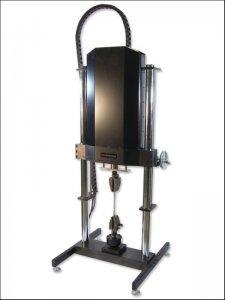
A fatigue test helps determine a material’s ability to withstand cyclic fatigue loading conditions. By design, a material is selected to meet or exceed service loads that are anticipated in fatigue testing applications. Cyclic fatigue tests produce repeated loading and unloading in tension, compression, bending, torsion or combinations of these stresses. Fatigue tests are commonly loaded in tension – tension, compression – compression and tension into compression and reverse.
To perform a fatigue test a sample is loaded into a fatigue tester or fatigue test machine and loaded using the pre-determined test stress, then unloaded to either zero load or an opposite load. This cycle of loading and unloading is then repeated until the end of the test is reached. The test may be run to a pre-determined number of cycles or until the sample has failed depending on the parameters of the test.
Purpose of fatigue testing:
Usually the purpose of a fatigue test is to determine the lifespan that may be expected from a material subjected to cyclic loading, however fatigue strength and crack resistance are commonly sought values as well. The fatigue life of a material is the total number of cycles that a material can be subjected to under a single loading scheme. A fatigue test is also used for the determination of the maximum load that a sample can withstand for a specified number of cycles. All of these characteristics are extremely important in any industry where a material is subject to fluctuating instead of constant forces.
Types of fatigue tests:
There are several common types of fatigue testing as well as two common forms: load controlled high cycle and strain controlled low cycle fatigue. A high cycle test tends to be associated with loads in the elastic regime and low cycle fatigue tests generally involve plastic deformations.
Types of materials for fatigue tests:
Nearly all materials may experience fatigue in one way or another during the lifespan of their application. However, in applications where fatigue is a factor it is common to find components made from metals or composites. These materials have a higher fatigue limit than others because of the rigidity and ductility, which are characteristics that tend to increase fatigue strength. Other materials, such as, polymers, ceramics and wood may experience fatigue and also need to be tested to understand how they will respond to these unique stress combinations.
Selected Test Standards
- ASTM C1368 Slow Crack Growth of Ceramics in Flexure
- ASTM C394 Shear Fatigue - Sandwich Core Materials
- ASTM D3479 Tension-Tension Fatigue of Polymer Matrix Composite Materials
- ASTM D7774 Flexural Fatigue Test Equipment for Plastics
- ASTM E2207 Axial-Torsional Fatigue Thin-Walled Tubular Materials Test Equipment
- ASTM E2368 Thermomechanical Fatigue Test Equipment
- ASTM E2714 Creep Fatigue High Temperature Test Equipment
- ASTM E466 Load Controlled Constant Amplitude Fatigue Tests of Metals
- ASTM E467 Constant Force Axial Fatigue Test System Test Machines
- ASTM E606 Strain-Controlled High and Low Cycle Fatigue Testing
- ASTM E647 Fatigue Crack Growth Test Equipment
- ASTM F1612 Cyclic Fatigue Testing Hip Arthroplasty Femoral Components
- ASTM F1717 Spinal Implant Static and Fatigue Test Equipment
- ASTM F1798 Static and Fatigue Properties of Interconnection Mechanisms and Subassemblies Used in Spinal Arthrodesis Implants
- ASTM F1800 Fatigue Knee Joint Replacement Test Equipment
- ASTM F1820 Fatigue Test Machine Modular Acetabular Device
- ASTM F2118 Fatigue Testing Equipment for Acrylic Bone Cement
- ASTM F2193 Fatigue Bending Surgical Fixation Spinal Skeletal Test Equipment
- ASTM F382 Flexural Fatigue Bone Plate Fixation Devices Test Equipment
- ISO 14801 Fatigue Dental Implants Test Equipment
- ISO 15024 Interlaminar Fracture Toughness of Plastic Composites Test Machines
- ISO 22675 Fatigue ankle foot device Prosthetic Test Equipment
- ISO 7206 Hip Implants Tests
- NASM 1312-11 Tension Fatigue Test Procedure for Aeronautical Fasteners
Selected Applications
- Accelerated Fatigue Life Tests (SSALT) of Dental Implants
- Aircraft Structural Testing | Equipment
- Ankle Prosthetic Durability Fatigue Test System | 810-22675 Model
- Ceramic Matrix Composites Fatigue Test Equipment
- Dental Implant Fatigue Test Equipment
- Fatigue Test Equipment for Polymer Matrix Composites
- Fatigue Test Machine for Cold Environments | TestResources
- Fatigue Test Machines for Honeycomb Composites
- Fatigue Testing at Cryogenic Temperatures
- Fatigue Testing Metal Matrix Composites
- Fatigue Testing of Ceramic Matrix Composites
- Fatigue Testing Spine Implants
- Fatigue Testing the Tibial Tray Component
- Fatigue Testing UHMWPe Tibial Bearing Components
- High Cycle Fatigue (HCF) of MetalsHigh Strain Rate
- High Elongation Tensile and Fatigue Test of Silicone Rubber
- Hip Implant Fatigue ASTM Test Equipment per ISO 7206 | TestResources
- Hip Implant Fatigue Testing Femoral Head, Stem, Acetabular Shell and Linear | TestResources
- Honeycomb Composite Fatigue Test Equipment
- Low Cycle Fatigue (LCF) of Metals at High Temperature
- Low Force Electrodynamic Fatigue Test Machine
- Metal Chain Static and Fatigue Test Application
- Metal Matrix Composites Fatigue Test Equipment
- Metals Fatigue Testing at High Temperatures
- Rubber & Elastomer Fatigue Test Machine
- Stainless Steel Fatigue Cryogenic Tests
- Strain Controlled Low Cycle Fatigue Testing Equipment
- Testing Metals for Thermo Mechanical Fatigue (TMF) Life | Equipment
- Testing Rubber and Elastomeric Dynamic Vibration Isolators
- Water Pressurization Fatigue Test System
